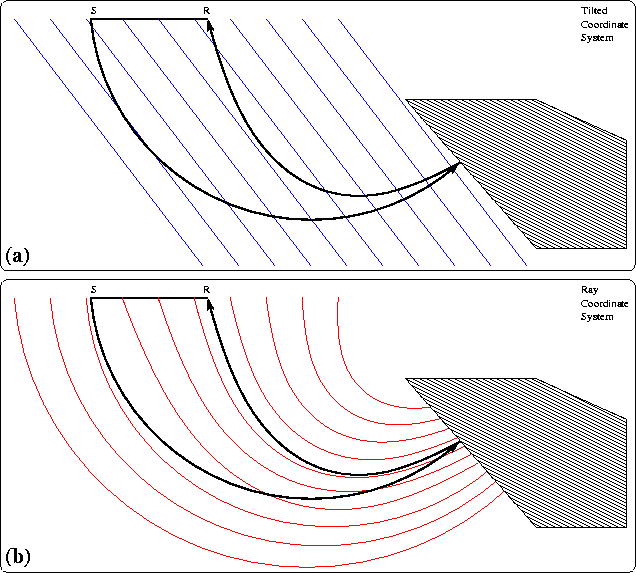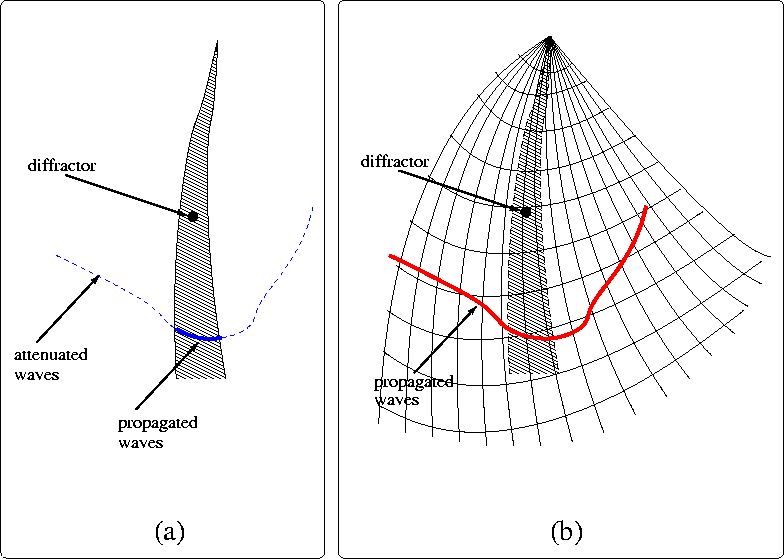




Next: Acoustic wave-equation
Up: Riemannian wavefield extrapolation
Previous: Overview
Imaging complex geology is one of the main challenges of today's
seismic processing.
Of the many seismic imaging methods available,
downward continuation (24)
is accurate, robust, and capable of handling
models with large and sharp velocity variations.
This method naturally handles the multipathing
that occurs in complex geology and provide a band-limited
solution to the seismic imaging problem.
Furthermore, as computational power increases, such methods
are gradually moving into the mainstream of seismic
processing.
This explains why one-way wave extrapolation has been a
subject of extensive theoretical research in the recent years
(110; 49; 51; 7; 81).
However, migration by downward
continuation imposes strong limitations on the dip of reflectors
that can be imaged since, by design, it favors
downward propagating energy.
Upward propagating energy, for example overturning waves,
can be imaged in principle using downward continuation
methods (42), although the procedure
is difficult, particularly for prestack data.
In contrast, Kirchhoff-type methods based on ray-traced
traveltimes can image steep dips and handle
overturning waves, although those methods are far less
reliable in complex velocity models given their
asymptotic assumption (40).
The steep-dip limitation of downward continuation techniques has
been addressed in several ways:
A first option is to increase the
angular accuracy of the extrapolation operator, for example by
employing methods from the Fourier finite-difference (FFD)
family (7; 81), or the
Generalized Screen Propagator (GSP) family
(49; 51).
The enhancements brought about by these methods
have two costs: (1) they increase the cost of extrapolation, and
(2) they do not guarantee unconditional stability.
A second option is to perform the wavefield extrapolation
in tilted coordinate systems (34),
or by designing sources that favor illumination of
particular regions of the image
(21; 80).
We can thus increase angular accuracy, although these methods
are best suited for only a subset of the model
(a salt flank, for example),
and potentially decrease the accuracy in other regions of the model.
In complex geology,
defining an optimal
tilt angle for the extrapolation grid is not obvious.
A third possibility is hybridization of
wavefield and ray-based techniques, either in the form
of Gaussian beams
(19; 39; 46; 47),
coherent states
(4; 5),
or beam-waves
(15).
Such techniques are quite powerful, since they
couple wavefield methods with
multipathing and band-limited properties, with
ray methods, which deliver arbitrary directions
of propagation, even overturning.
Beams can be understood as localized wave packets
propagating in the preferential direction
(117).
Numerically, they are usually implemented using localized
extrapolation paths.
Extrapolation
beams may leave shadow zones in various parts
of the model, which hamper their imaging abilities.
Furthermore, extrapolation beams have limited width,
and do not allow diffractions from sharp features in the
velocity model to develop completely without being
attenuated at the boundaries.
In addition, the narrow
extrapolation domain generates beam superposition
artifacts, such as beam boundary effects.
We can recognize that Cartesian coordinates for downward
and tilted continuation or along beams of limited spatial extent,
are just mathematical conveniences that do not reflect a
physical reality.
A better idea is to reformulate wavefield
extrapolation in general Riemannian coordinates that conform
with the general direction of wave propagation,
thus the name Riemannian wavefield extrapolation (RWE).
We can formulate the wavefield extrapolation theory in arbitrary 3D
semi-orthogonal Riemannian spaces (79),
where the extrapolation direction
is orthogonal to all other directions.
Examples of such coordinate systems include, but are not limited
to, fans of rays emerging from a source point,
or bundles of rays initiated by plane waves of arbitrary
initial dips at the source.
For constant background velocity,
this method reduces to
extrapolation in polar/spherical coordinates
(64; 65),
or extrapolation in tilted coordinates
(34).
This method is also closely related to Huygens wavefront tracing
(92),
which represents a finite-difference
solution to the eikonal equation in ray coordinates.
The main strength of this method is that the coordinate system
can follow the waves, which may overturn, such that
we can use one-way extrapolators to image
diving waves (overturned).
overturned
Figure 1
Ray coordinate systems are superior to tilted coordinate
systems for imaging overturning waves using one-way
wavefield extrapolators.
Overturning reflected energy may become evanescent
in tilted coordinate systems (a),
but stays non-evanescent in ray coordinate systems (b).

We can also use inexpensive
extrapolators with limited angle accuracy (e.g.  ),
since, in principle, we are never too far from the
wave propagation direction, and those methods deliver
unconditional stability.
We are also not confined to the extent
of any individual extrapolation
beam, therefore we can track diffractions
for their entire spatial extent (beams).
),
since, in principle, we are never too far from the
wave propagation direction, and those methods deliver
unconditional stability.
We are also not confined to the extent
of any individual extrapolation
beam, therefore we can track diffractions
for their entire spatial extent (beams).
beams
Figure 2 Extrapolated energy is attenuated
at beam boundaries (a), but is propagated in a Riemmanian
coordinate system (b).






Next: Acoustic wave-equation
Up: Riemannian wavefield extrapolation
Previous: Overview
Stanford Exploration Project
11/4/2004

